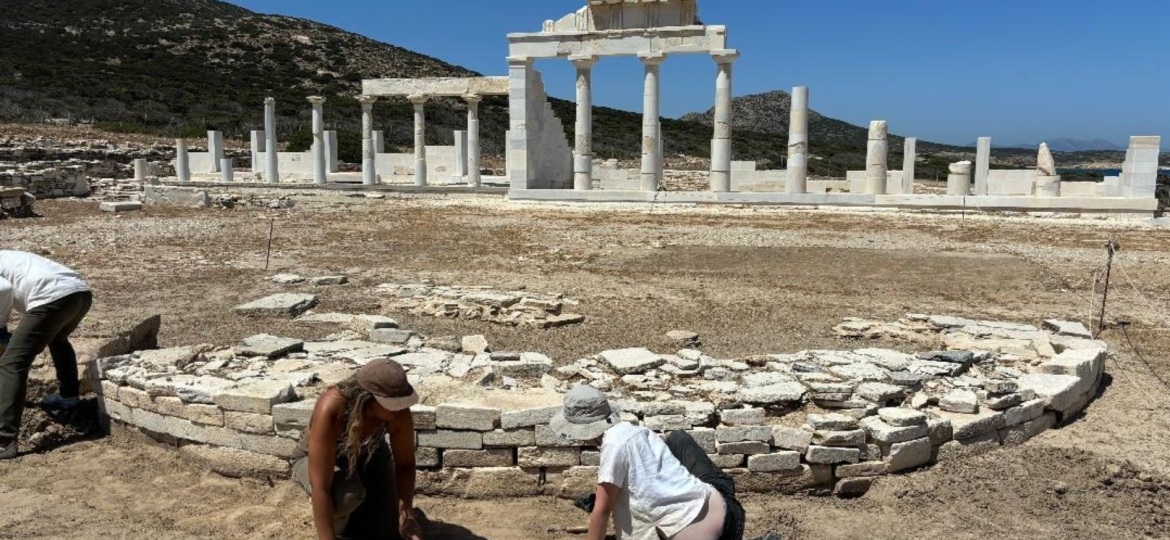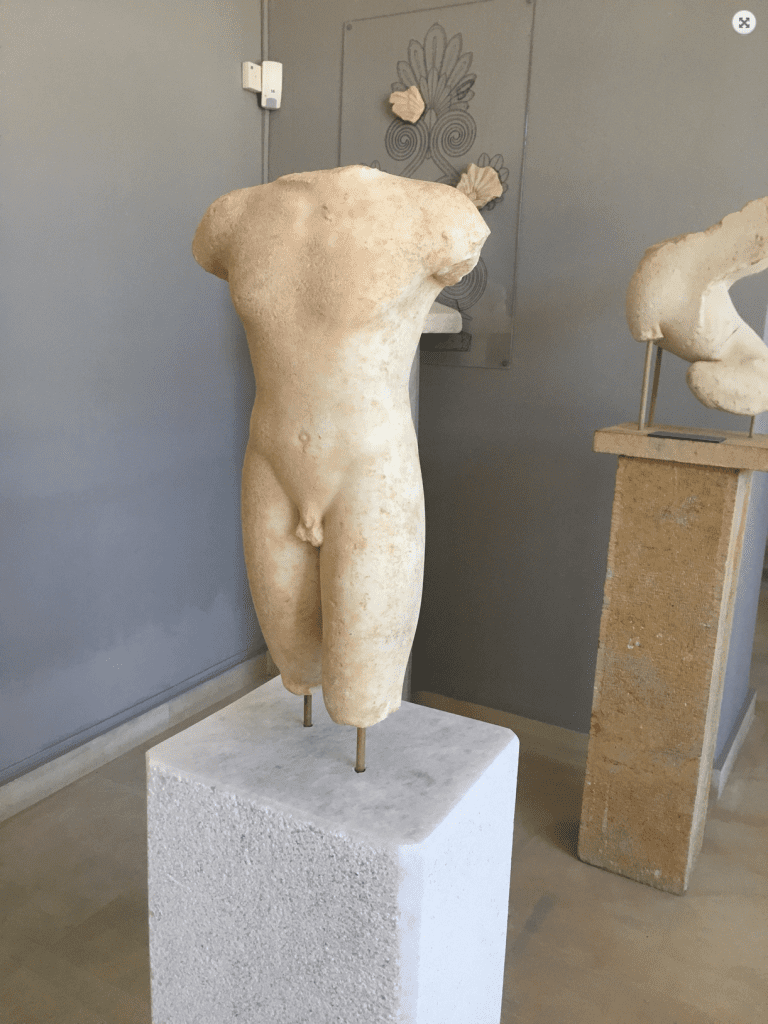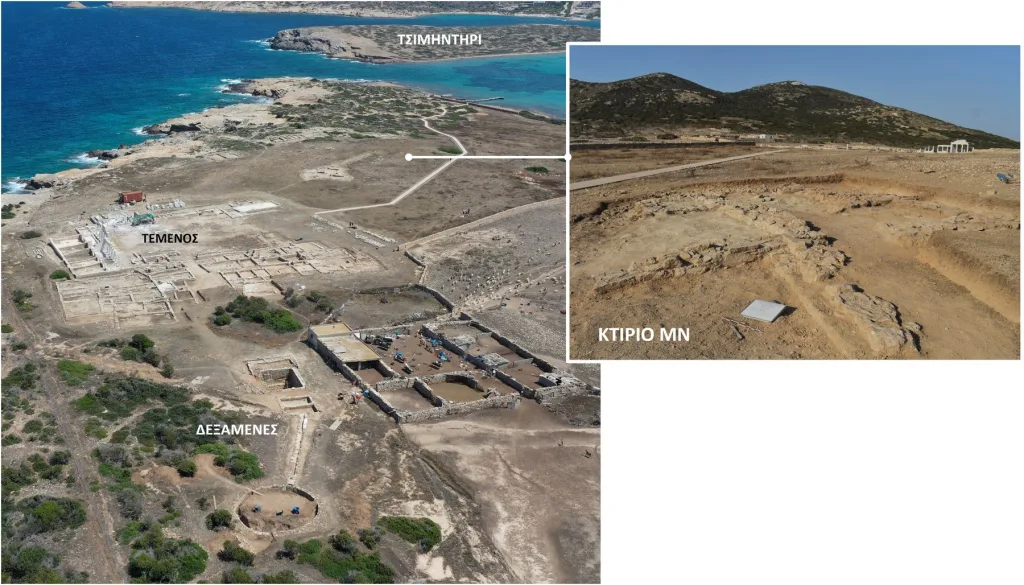
The systematic excavation carried out by the Ephorate of Antiquities of the Cyclades under the direction of archaeologist Giannos Kouragios lasted six weeks this year, from May 20 to June 28, 2024, and focused both on the Mantra site on the islet of Despotiko, and on the islet of Tsimientiri. The excavation was carried out with the collaboration of archaeologists Alexandra Alexandridou (Associate Professor of Archeology at the University of Ioannina), Ilias Daifa (Dr. Archaeologist), Erica Angliker (Dr., Research Associate -British School at Athens), while Caspar Meyer ( Dr., Bard Graduate Center), Luigi Lafasciano (Dr., Univeristy of Salerno), Katerina Karakassi (Dr. Archaeologist), Doug Forsyth (Dr., University of St Andrews), the graduate students of the University of Ioannina Louiza Panopoulou, Cleo Papathanasiou , Eftychia-Maria Houmadaki and a large number of volunteer students from Universities in Europe, America, Brazil and Greece (College Year in Athens/DIKEMES, JICAS Center, Bard Graduate Center N.Y., University of Ioannina, etc.).
The work was made possible thanks to the support of AEGEAS AMKE (Thanasis and Marina Martinou), the P&A Kanellopoulos Foundation, the A.G. Leventis Foundation, Marion Stassinopoulos, the “Friends of Paros” and “Antiparos Preservation Society”.

Work focused on the buildings located outside the archaic mosque in the area between it and the coast. The investigation of the MN Building that had been identified in 2023 continued (Fig.1). The building dates back to the second half of the 6th century BC. It has a rectangular floor plan and eight of its rooms have come to light. Their walls are 0.45-0.48 m wide, except in the south and west where the walls are “double” with a thickness of almost 1.20 m. They are made of medium and large slab-shaped and roughly hewn stones and architecturally they do not differ from the other buildings that have already been excavated outside the mosque. In Rooms 2 and 3 four-sided constructions were found, while in the middle of Room 5 there is an elongated “groove” 1.70 m long, for water drainage. Inside the rooms were found many clay pots from the roof of the building, as well as part of an acrokeram in the form of a mermaid. Based on the architectural details, at least two architectural phases of the MN building can be identified. The excavation of the so-called “Building O”, in the environment of which in 2023 the fragments of at least three kours, a male statue of austere rhythm, marble bases and figurines and which had been considered a kind of propylon (Fig. 2, 3, 4 ) continued this year with the investigation of the large collapse inside the building, between walls T1 and T3. From the study of the stratigraphy and the pottery, it seems very likely that the two walls experienced two phases of construction and repair, with the earliest in the 6th century BC. In the N/NW area of Building Z, which is located outside but very close to the mosque and whose main phase is placed in the first half of the 5th c. BC, another room of the archaic building Za was uncovered, which had been identified last year, just below the paved atrium of Z and its northernmost rooms. The earliest building seems to have had an opposite orientation to its “successor” and consisted of at least 3 rooms in a row, inside which a significant amount of archaic pottery was discovered. Small-scale cleanings were carried out in the southernmost room 11 of the large Building B, where a large concentration of shells and pottery of the 6th and 5th centuries BC came to light, confirming the residential/secular use of the building and the wide period of its operation from early 6th to 5th c. B.C. After the completion and submission for approval of the restoration and enhancement study of the archaic tank system (architect Goulielmos Orestidis), the final cleaning of the central Tank 1 was carried out with the removal of the newer embankments from its SW corner (Fig.5,6) .

Tsimintiri
The small island of Tsimientiri is located between the bay of Ag. Georgiou of Antiparos and Mantra of Despotikos, with which it was connected through a narrow strip of land, an isthmus. Its name is a paraphrase of the word cemetery, since Proto-Cycladic tombs were excavated on the south coast of the island, unfortunately captured. A short investigation in 2011 had led to the identification of the rectangular AT Building consisting of at least three rooms in a B-S configuration. The continuation of excavation work in 2019 and 2020, again for short periods of time due to the difficulty of accessing the islet, led to the identification of the BT, GT, DT, ET buildings, at the eastern end of the islet, a large circular building (ZT Building), as well as parts of two more rectangular buildings (TT and HT) near the AT Building. During this year’s excavation season, due to the installation of a floating platform – which was donated to the excavation by the Antiparos Preservation Society – a more systematic investigation of the buildings at Tsimintiri was possible for a month. It was found that most of the buildings that had been investigated in previous years and were considered to be independent structures actually make up two large building complexes, the AT and the BT which are arranged along the southern side of the islet towards the leeward gulf and with a direct view towards the sanctuary in Despotiko (Fig.7). AT Building Complex: The continuation of the excavation of the AT and HT buildings proved that they probably form a large Building Complex, the AT (Fig.8). It is a rectangular complex with at least 6 rooms lined up east and west of a courtyard. Its visible dimensions are 18m (N-S) X 23m (E-W). Probably in a later phase, the so-called ΘΤ building, with visible dimensions of 11m (N-S) X 6.5m (E-W), was attached to the north side of the complex. The continuation of their excavation is expected next summer, to clarify the connection of the western part of the complex (the so-called AT building) with the eastern (the so-called HT building) and the northern part (the so-called TT building). At a distance of about 30m to the northwest of the above buildings, a rectangular building, the IT Building, with dimensions of 7.80m (E-W) X 10m (N-S) was revealed, the excavation of which was not completed. Building Complex BT : On the eastern side of the island where the so-called Buildings BT, GT DT, and ET were uncovered, it was found that these make up the large-scale Building Complex BT (Fig. 9). Its plan is rectangular and its visible dimensions are approximately 45m (E-W) X 18m (N-S). The northernmost wall of the complex reaches a length of 41.50 m and defines, on the northern side of the complex, a series of 10 rooms, of varying dimensions, which are aligned in an E-W direction. The southern rooms of the complex are also defined externally by the same 24m long wall. Although between the north and south rows of rooms – in the middle of the complex – the excavation has not been completed, and several of its walls have been destroyed, it is clear that the design of the complex follows the philosophy of organizing many spaces of varying dimensions around large courtyards . What was not made clear is whether there was a single rectangular courtyard or a second smaller one (Fig. 10). In more detail, the easternmost end of the complex, just a few meters from the current coast, consists of a four-sided space (X2) with an area of 129 sq.m. On its north side are two rooms of equal size, while on its south side a small rectangular space without an entrance, which is abutted by a 2.70 m wide stone ramp, through which the space was accessed. In front (west) of X2 opens a large rectangular space, probably a courtyard (X4), the western border of which is not preserved. An extensive collapse was excavated inside it this year. North and south of the courtyard, six and four rooms, respectively, are preserved (Fig. 11). The western part of the building complex has been preserved in very good condition. On its northern side are two quadrilateral spaces that share the same wall as the aforementioned northern spaces. They communicate with a large courtyard area, part of which is covered with paving. South of this perhaps more spaces were opening up, but the area needs further investigation. The earliest ceramic finds from Complexes AT and BT belong to the Early Archaic period, late 7th/early 6th century, however the majority date to the late 6th and 5th centuries BC. A small amount of vases also dates to the 4th c. B.C. Many fragments of large piths with relief decoration of the “metopes – triglyphs” type were found, but also with wavy bands, fragments of commercial amphorae, ink-painted pottery of the 6th and 5th centuries BC, and several clay pyramid-shaped hearths (Fig. 12). Of particular interest is a marble object, probably a bath.
The dimensions of the complex, its architectural form, its spatial relationship with the sheltered bay and the type of finds – mainly the commercial amphorae and pithos – indicate port facilities that served, among other things, for the storage of products. Proto-Cycladic burial: This year’s excavation period brought us a big surprise during the investigation of Complex BT, as during the investigation of the interior of Room 5 at the NW end of the Complex, a trapezoidal, box-shaped structure of vertically placed stone slabs was identified (Fig. 13). Excavation of its interior to a depth of about 0.15 cm from the upper surface of the slabs yielded some sherds from the rim of an archaic amphora and the base of a modern open small vessel. However, a deeper investigation revealed that it is a box-shaped tomb of the Proto-Cycladic period, which had not been captured. The trapezoidal tomb measured 3.30 m on its west side, 2.20 m on the east, 2.90 m on the north and 3.00 on the south. Near the SW corner of the tomb was uncovered an intact marble conical cup which must have been placed upright. Almost in contact with the western side of the tomb, a shallow clay bottle was found, inside which a spherical compass had been placed, and a little further to the north, at a greater distance from the side of the tomb, a beak-shaped spout with a straight rim (Fig. 14). In about the center of the eastern side and almost in contact with it, an intact clay disk-shaped flywheel was found. The bones were found concentrated mainly in the southern half, and in particular in the SW corner of the tomb. The deceased had been placed in a very shy position with the skull probably in the SE corner with the hands folded in front of the face. A slab had been placed on the floor of the tomb, but it covered almost half of it. Based on the offerings, the burial can be safely dated to the Proto-Cycladic I period – at the end of the 4th millennium BC. This grave should belong to the same cemetery as those excavated in 2003 by Giannos Courage. The interest of the find lies in the fact that the burial was incorporated into the specific area of the complex which must have been founded sometime in the 6th century BC at the latest. and was used as a storage space without its users knowing that it was a tomb (Fig.15). In addition to the above, the plan of one more circular structure with a diameter of 17m was revealed (now three are visible on the islet and one in Despotiko) (Fig.16). Its poor state of preservation does not currently allow conclusions to be drawn about its use.

This year, the restoration of the four-pillar vestibule of Building D, the second most important building of the mosque, continued this year (Fig. 17-18). ancient and new material, but also the facade of the building made of marble structures. Finally, the NW corner of the foundation was restored in order to place the masonry of marble blocks worked with a thick needle. The restoration work, lasting 3 weeks, was carried out by the skilled marble craftsmen V. Hatzis. M. Armao, G. Skari, G. Palamaris, L. Ioannou, G. Kontonikolau under the supervision of the architect Goulielmos Orestides.
Fixing-maintenance works
In addition, masonry maintenance and mortar fixing works were carried out by the conservator Giorgos Karambalis and Eva Tsavos, in Buildings Z and Y in Despotiko, but also in the premises of the Bt Complex in Tsimientiri.
Διαβάστε αυτή τη σελίδα στα: 

Please Inform about 2025